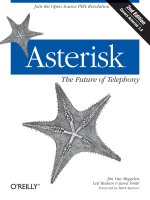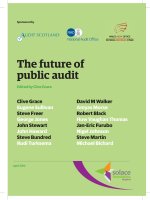- Trang chủ >>
- Khoa Học Tự Nhiên >>
- Vật lý
the future of public employee retirement systems oct 2009
Bạn đang xem bản rút gọn của tài liệu. Xem và tải ngay bản đầy đủ của tài liệu tại đây (1.26 MB, 365 trang )
The Future of Public Employee
Retirement Systems
This page intentionally left blank
The Future of Public
Employee Retirement
Systems
EDITED BY
Olivia S. Mitchell and Gary Anderson
1
3
Great Clarendon Street, Oxford ox2 6dp
Oxford University Press is a department of the University of Oxford.
It furthers the University’s objective of excellence in research, scholarship,
and education by publishing worldwide in
Oxford New York
Auckland Cape Town Dar es Salaam Hong Kong Karachi
Kuala Lumpur Madrid Melbourne Mexico City Nairobi
New Delhi Shanghai Taipei Toronto
With offices in
Argentina Austria Brazil Chile Czech Republic France Greece
Guatemala Hungary Italy Japan Poland Portugal Singapore
South Korea Switzerland Thailand Turkey Ukraine Vietnam
Oxford is a registered trade mark of Oxford University Press
in the UK and in certain other countries
Published in the United States
by Oxford University Press Inc., New York
© Pension Research Council, The Wharton School, University of Pennsylvania, 2009
The moral rights of the authors have been asserted
Database right Oxford University Press (maker)
First published 2009
All rights reserved. No part of this publication may be reproduced,
stored in a retrieval system, or transmitted, in any form or by any means,
without the prior permission in writing of Oxford University Press,
or as expressly permitted by law, or under terms agreed with the appropriate
reprographics rights organization. Enquiries concerning reproduction
outside the scope of the above should be sent to the Rights Department,
Oxford University Press, at the address above
You must not circulate this book in any other binding or cover
and you must impose the same condition on any acquirer
British Library Cataloguing in Publication Data
Data available
Library of Congress Cataloging in Publication Data
Data available
Typeset by SPI Publisher Services, Pondicherry, India
Printed in Great Britain
on acid-free paper by
MPG Books Group, Bodmin and King’s Lynn
ISBN 978–0–19–957334–9
13579108642
Contents
List of Figures vii
List of Tables ix
Preface xii
Notes on Contributors xiv
Abbreviations xx
1. The Future of Public Employee Retirement Systems 1
Olivia S. Mitchell
Part I. Costs and Benefits of Public Employee
Retirement Systems
2. Estimating State and Local Government Pension and Retiree
Health Care Liabilities 19
Stephen T. McElhaney
3. The Case for Marking Public Plan Liabilities to Market 29
Jeremy Gold and Gordon Latter
4. Between Scylla and Charybdis: Improving the Cost Effectiveness
of Public Pension Retirement Plans 58
M. Barton Waring
5. Public Pensions and State and Local Budgets: Can Contribution
Rate Cyclicality Be Better Managed? 75
Parry Young
6. Benefit Cost Comparisons Between State and Local
Governments and Private Industry Employers 85
Ken McDonnell
7. Administrative Costs of State Defined Benefit and Defined
Contribution Systems 97
Edwin C. Hustead
8. Thinking about Funding Federal Retirement Plans 105
Toni Hustead
vi Contents
Part II. Implementing Public Retirement
System Reform
9. Reforming the German Civil Servant Pension Plan 115
Raimond Maurer, Olivia S. Mitchell, and Ralph Rogalla
10. The Outlook for Canada’s Public Sector Employee Pensions 143
Silvana Pozzebon
11. Unifying Pension Schemes in Japan: Toward a Single Scheme for
Both Civil Servants and Private Employees 164
Junichi Sakamoto
12. Redefining Traditional Plans: Variations and Developments in
Public Employee Retirement Plan Design 187
Keith Brainard
13. Defined Contribution Pension Plans in the Public Sector:
A Benchmark Analysis 206
Roderick B. Crane, Michael Heller, and Paul J. Yakoboski
Part III. The Political Economy of
Public Pensions
14. The Evolution of Public Sector Pension Plans in the
United States 239
Robert L. Clark, Lee A. Craig, and Neveen Ahmed
15. Pension Fund Activism: The Double-Edged Sword 271
Brad M. Barber
16. The New Intersection on the Road to Retirement: Public
Pensions, Economics, Perceptions, Politics, and Interest Groups 294
Beth Almeida, Kelly Kenneally, and David Madland
Index 327
List of Figures
3-1 Comparison of Entry Age Normal (EAN) liabilities to
Accrued Benefit Obligation (ABO) liabilities. Assumed
salary scale: 0 percent 38
3-2 Comparison of Entry Age Normal (EAN) liabilities to
Accrued Benefit Obligation (ABO) liabilities. Assumed
salary scale: 5 percent 42
3-3 Nominal interest rates: actuarial versus market 44
3-4 Real interest rates: actuarial versus market 46
3-5 Treasury interest rates, real and break-even inflation rates
(as of 3/31/2008) 46
5-1 Employer contributions as percent of state and local
government payroll 77
5-2 Estimated impact of recommended method as if
implemented 10 years ago 80
9-1 Age distribution of active civil servants in 2004 119
9-2 Range of pension costs under alternative asset allocations 130
9-3 Time paths of supplementary public pension
contributions and cost savings under optimal asset
allocation strategy.
Panel A. Probabilities of supplementary contributions and
contribution holidays over time.
Panel B. Magnitudes (in billions of 2004 euros) of
expected supplementary contributions and cost saving
due to contribution holidays 133
10-1 Percentage of paid workers covered by a Registered
Pension Plan (RPP), total and by sector, Canada: 1981–2006 146
10-2 Percentage of registered pension plan members in
defined benefit and defined contribution plans by sector,
Canada: 1974–2007 (at January 1) 148
10-3 Asset allocation of trusteed public sector pension funds,
Canada: 1992–2006 (percentage of total assets at market value) 155
10-4 Asset allocation of trusteed private sector pension funds,
Canada: 1992–2006 (percentage of total assets at market value) 156
11-1 Japan’s current social security pension schemes 165
viii List of Figures
11-2 Financing basic pension benefits in Japan 173
11-3 Merging the Mutual Aid Associations (MAAs) for Japan
Railway Company (JR), Salt and Tobacco Monopoly
Enterprise (JT), and Nippon Telegraph and
Telecommunications Enterprise (NTT) employees with
the Employees’ Pension Insurance (EPI) scheme 176
14-1 Mean income replacement rates, state pension plans, by
years of service, 1982 and 2006 248
14-2 Mean income replacement rates of state pension plans, by
social security coverage, 1982 249
14-3 Mean income replacement rates of state pension plans, by
social security coverage, 2006 249
15-1 Relation between agency costs, monitoring expenditures,
and portfolio value.
Panel A. Agency costs and monitoring expenditures.
Panel B. Shareholder expenditures on monitoring and
portfolio value 275
15-2 Cumulative market-adjusted returns for CalPERS focus list
firms, 1992 to 2007 283
15-3 Cumulative gains from CalPERS shareholder activism for
different horizons 287
16-1 Effect of various factors on the probability of introducing
a defined contribution plan 305
List of Tables
3-1 Summary of data from four public pension plans’
Comprehensive Annual Financial Reports (CAFRs: $mm
for aggregate financial values) 37
3-2 Factors used to convert Entry Age Normal (EAN)
Accrued Actuarial Liabilities (AAL) to Accumulated
Benefit Obligation (ABO). Assumed salary scale: 0 percent 39
3-3 Factors used to convert Entry Age Normal (EAN)
liabilities to Accumulated Benefit Obligation (ABO)
liabilities. Assumed salary scale: 5 percent 40
3-4 Converting Entry Age Normal (EAN) liabilities to
Accumulated Benefit Obligation (ABO) liabilities:
various salary assumptions 43
3-5 First adjustment: converting the Actuarial Accrued
Liability (AAL) to Accumulated Benefit Obligation (ABO) 43
3-6 Second adjustment: converting the Accumulated Benefit
Obligation (ABO) to a Market Value Liability (MVL) 45
3-7 Comparison of funded status: Actuarial vs. Market 47
5-1 Employer contributions as a percent of state and local
government payroll 77
6-1 Employer costs for employee compensation and
percentage of full-time employees participating in
employee benefit programs: state and local
governments: 1998 and 2007 86
6-2 Employer costs for employee compensation and
percentage of full-time employees participating in
employee benefit programs: private industry 88
6-3 Employment and total compensation costs, by industry
group and union membership, state and local
governments and private sector: 2007 91
6-4 Employment and total compensation costs in state and
local governments and private sector by occupation
group, ages 16 and older 93
7-1 Annual administrative expenses for state retirement
plans as a percentage of contributions and assets 99
x List of Tables
7-2 Administrative expenses of Federal plans 101
9-1 Projected benefit liabilities and contribution rates:
deterministic model 122
9-2 Simulated parameters for stochastic asset case 128
9-3 Risk of alternative asset allocation patterns assuming
fixed contribution rate 129
9-4 Optimal asset allocation patterns for alternative
parameterizations 135
9-A1 Estimated quarterly VAR parameters 138
10-1 Overview of public and private sector Registered
Pension Plans (RPPs), Canada, 2007 (at January 1) 145
10-2 General characteristics of public and private sector
registered pension plans, Canada 2007, at January 1
(percent of members) 148
10-3 Design features of public and private sector Defined
Benefit Registered Pension Plans, Canada 2007, at
January 1 (percent of members) 150
10-4 Contributions to public and private sector Registered
Pension Plans, Canada 2007, at January 1 151
11-1 Contribution programs for each scheme for employees 179
12-1 Earnings and dividend credit rates applied to accounts
in the Nebraska Public Employee Retirement System
cash balance plan, 2003–2007 189
12-2 Comparison of inflation-adjusted benefit with and
without the Minnesota Teachers’ Retirement Association
deferred annuity benefit 198
12-3 Earnings credit applied to individual accounts in the
Oregon Public Employee Retirement System, 2004–2007 200
12-4 Defined benefit plans with mandatory defined
contribution components sponsored by state governments 201
13-1 Retirement income targets 209
13-2 Retirement income replacement projections under a
defined contribution plan 211
13-3 Best practice recommendations for core defined
contribution plan design in the public sector 212
13-4 Projected income replacement rates at retirement for
selected public core DC plans 218
List of Tables xi
13-A1 Comparison of best practice benchmarks to major
public sector core DC plans 223
14-1 Descriptive statistics, means, and standard deviations of
independent variables 252
14-2 Multivariate models of replacement ratios for state and
local employees, with 20 years of service, 1982 and 2006 253
14-3 Explanation of the percentage change in replacement
ratios for state employees with 20 years of service,
between 1982 and 2006 255
14-A1 Benefit formulas and retirement ages for state employee
pension plans, by state, 1982 and 2006 257
14-A2 Plan contributions and vesting requirements 263
15-1 Announcement day market-adjusted returns and
valuation impact for CalPERS focus list firms by year,
1992 to 2007 281
15-2 Daily abnormal returns (Alpha) to value-weighted
portfolios of CalPERS focus list firms at different
holding periods, 1992 to 2007 285
16-1 Empirical determinants of the public’s self-reported
preferences for plan type and plan features 303
Preface
Many millions of pension plan participants all over the world have recently
awakened to the sad fact that financial market collapse can—virtually
overnight—erode a lifetime of saving for old age. The shock is made
worse by the fact the global age wave is also cresting, with rising numbers
of elderly and declining working-age populations to support them. This
volume focuses on the retirement systems provided to public sector employ-
ees, paying careful attention to their costs, their benefits, and their future
in light of these current financial and demographic challenges.
There is no question but that those covered by public pensions are
often the subject of ‘pension envy’: that is, their benefits might seem more
generous and their contributions lower than those offered by the private
sector. Yet this volume points out that such judgments are often inaccurate,
since civil servants hold jobs for with few counterparts in private industry,
such as firefighters, police, judges, and teachers. Often these are riskier,
dirtier, and demand more loyalty and discretion than would be required of
a more mobile labor force in the private sector. In any event, there remains
ample room for comparative and analytic judgment. Accordingly, one focus
of this book is on financial aspects of these schemes, addressing the cost and
valuation debate. Another is the political economy of how public pension
asset pools are perceived and managed, an increasingly important topic in
times of global financial turmoil. And finally we undertake an international
comparison of public retirement system reform, exploring ways that public
pensions can be strengthened in the United States, Japan, Canada, and
Germany. We are thus happy to represent the vigorous debate currently
underway by academics, financial experts, regulators, and plan sponsors,
all seeking to define a new future for public retirement systems.
Previous research studies directed at the Pension Research Council and
the Boettner Center of the Wharton School of the University of Penn-
sylvania have focused on public and private pensions as well as retire-
ment adequacy in the United States and around the world. As with all of
our research volumes, we owe much to our fine contributors, coeditors,
and conference participants. In this instance, Gary Anderson served as a
wonderful co-organizer and we owe him many thanks. The Senior Part-
ners and Institutional Members of the Pension Research Council are also
very much appreciated for their intellectual and financial support. The
Wharton School provided conference facilities and funding, permitting
the initial research findings to be reported. Additional financial sustenance
Preface xiii
was received from the Pension Research Council, the Boettner Center for
Pensions and Retirement Research, and the Ralph H. Blanchard Memor-
ial Endowment at the Wharton School of the University of Pennsylvania.
The manuscript was expertly prepared and carefully edited by Andrew
Gallagher and Matt Rosen, with assistance from Hilary Farrell.
On behalf of these institutions and individuals, we thank all of our fine
collaborators and supporters for their help and intellectual guidance in
these times of financial turmoil.
Olivia S. Mitchell
Pension Research Council
Boettner Center for Pensions and Retirement Research
The Wharton School
The Pension Research Council
The Pension Research Council of the Wharton School at the University
of Pennsylvania is an organization committed to generating debate on key
policy issues affecting pensions and other employee benefits. The Council
sponsors interdisciplinary research on the entire range of private and social
retirement security and related benefit plans in the United States and
around the world. It seeks to broaden understanding of these complex
arrangements through basic research into their economic, social, legal,
actuarial, and financial foundations. Members of the Advisory Board of
the Council, appointed by the Dean of the Wharton School, are leaders
in the employee benefits field, and they recognize the essential role of
social security and other public sector income maintenance programs while
sharing a desire to strengthen private sector approaches to economic secu-
rity. More information about the Pension Research Council is available on
the Internet at or send email to
Notes on Contributors
Neveen Ahmed is a doctoral candidate in Economics at North Carolina
State University studying US financial markets and public pensions. She
received her MA in economics from North Carolina State University and
her BSc in Economics from Cairo University.
Beth Almeida is the Executive Director of the National Institute on Retire-
ment Security, a not-for-profit organization that conducts research and
education programs on US pensions. She has worked previously with the
International Association of Machinists and Aerospace Workers and led
research initiatives at the University of Bonn’s Center for European Integra-
tion Studies; the European Institute for Business Administration; and the
Center for Industrial Competitiveness at the University of Massachusetts-
Lowell. She received her bachelor’s degree in International Business from
Lehigh University and her master’s degree in economics from the Univer-
sity of Massachusetts-Amherst.
Gary Anderson is a consultant on public pension issues; previously he
served as Executive Director of the Texas Municipal Retirement system
which covers municipal employees and retirees for many Texas cities. He is
also an Advisory Board member of Wharton’s Pension Research Council,
and has served with the National Association of State Retirement Adminis-
trators and the Government Finance Officers Association. He received his
BA in Political Science from Texas A&M University, and his MA in Public
Management from the University of Houston-Clear Lake City.
Brad M. Barber is a Professor of Finance at the Graduate School of Man-
agement, UC Davis. His recent research focuses on pension fund activism,
analyst recommendations, and investor psychology. At UC Davis, he teaches
courses in investment analysis and corporate financial policy. He received
his Ph.D. in Finance and his MBA from the University of Chicago, and his
BS in Economics from the University of Illinois.
Keith Brainard is the research director for the National Association of State
Retirement Administrators. His work focuses on governmental pension
plans and defined benefit pensions; he also maintains the Public Fund
Survey, an online compendium of public pension data. Mr. Brainard pre-
viously served as manager of budget and planning for the Arizona State
Retirement System, and he provided fiscal research and analysis for the
Notes on Contributors xv
Texas and Arizona legislatures. He received his MA from the LBJ School of
Public Affairs at the University of Texas-Austin.
Robert L. Clark is Professor of Economics and Professor of Management,
Innovation, and Entrepreneurship at North Carolina State University. His
research examines retirement decisions, the choice between defined ben-
efit and defined contribution plans, the impact of pension conversions
to defined contribution and cash balance plans, the role of information
and communications on 401(k) contributions, government regulation of
pensions, the development of public sector retirement plans, and Social
Security. He also studies economic responses to population aging in devel-
oped countries and international retirement plans, especially Japan. He
serves on Wharton’s Pension Research Council Advisory Board and is a
Governor of the Foundation for International Studies on Social Security.
Professor Clark earned his BA from Millsaps College and his MA and Ph.D.
from Duke University.
Lee A. Craig is Alumni Distinguished Professor of Economics at North
Carolina State University. His research focuses on long-run changes in US
agricultural productivity growth, the evolution and integration of agricul-
tural commodity markets, the gold standard and the history of business
cycles, and the history of public sector pensions and pension finance. He
has been affiliated with the National Bureau of Economic Research; a
trustee of the Economic History Association and the Cliometric Society;
a fellow of the Center for Demographic Studies at Duke University; a fellow
of the Seminar für Wirtschaftsgeschichte, Universität München, Germany;
and a member of the North Carolina Academy of Outstanding Teachers.
Professor Craig received his BS and MA from Ball State University and his
MA and Ph.D. from Indiana University.
Roderick B. Crane is the Director of Institutional Client Services at TIAA-
CREF, where he develops and executes strategies for the state and local
government 401(a), 457, 401(k), and 403(b) markets. He was previously a
senior consultant with The Segal Company and Mercer Human Resources
Consulting where he worked with large state and local governments on
the design and administration of their defined benefit and defined con-
tribution retirement programs as well as their deferred compensation and
retiree health savings plans. He has also served as staff legal counsel for
the North Dakota Legislative Assembly and its public employee retirement
oversight committee. He earned his BA in economics from the University
of North Dakota and the Juris Doctor from the University of North Dakota
School of Law.
Jeremy Gold provides pension finance consulting to sponsors of defined
benefit pension plans on investment analysis from an asset/liability point
xvi Notes on Contributors
of view, and strategic benefit advice from a corporate finance perspec-
tive. He previously headed Morgan Stanley Pensions, served as Consulting
Actuary/Account Executive at Buck Consultants, and worked with pension
consulting firms and insurance companies. He is a Fellow of the Society of
Actuaries; an Elected Board Member of the Society of Actuaries; a member
of the Pension Practice Council of the American Academy of Actuaries;
and a member of the Financial Economics Task force of the International
Actuarial Association. He received his Ph.D. from the Wharton School of
the University of Pennsylvania.
Michael Heller is Vice President or Actuarial Consulting Services at TIAA-
CREF, where he manages a number of actuarial functions primarily focused
on providing advice and assistance in the design and funding of both
defined benefit and defined contribution retirement plans. He earned his
BS in mathematics from the from the City College of New York; he also is a
Fellow of the Society of Actuaries, a Member of the American Academy of
Actuaries, and an Enrolled Actuary.
Edwin C. Hustead is former Senior Vice President in charge of the Arling-
ton, Virginia Hay Group actuarial practice and all Hay governmental actu-
arial and benefits consulting. He is responsible for analyzing the financial
condition of governmental employee retirement plans such as the Pennsyl-
vania State Employee’s Retirement System. He has consulted with Congress
in the design and implementation of the Federal Employees Retirement
System and has worked with the Society of Actuaries committees generating
the UP94, GAR94, and RP2000 mortality tables. He was previously Chief
Actuary of the Office of Personnel Management of the US Government.
He received his BA in Mathematics from Franklin and Marshall College.
He is also a Fellow of the Society of Actuaries, a member of the American
Academy of Actuaries, and an Enrolled Actuary.
Toni Hustead was Chief of the Veterans Affairs and Defense Health Branch
at the US Office of Management and Budget (OMB) in the Executive
Office of the President where she was in charge of assisting the President in
creating and implementing policies and budgets associated with veterans’
benefits and defense health issues, overseeing the management of these
programs, and ensuring that they aligned with other Presidential priorities.
As OMB’s only actuary, she was involved with accrual budgeting of Federal
entitlement programs. She was previously an international benefits consul-
tant for the Hay Group where she served as European Director of Benefits
Consulting. She also was Chief Actuary for the Department of Defense
and assisted the House Legislative Counsel’s Office in its drafting of the
legislation that actuarially funded the Military Retirement System. She is
Notes on Contributors xvii
a member of the American Academy of Actuaries and an Associate of the
Society of Actuaries.
Kelly Kenneally is a communications advisor to the National Institute on
Retirement Security, a not-for-profit organization conducting research and
education programs on US pensions. Her expertise is in the areas of
finance, corporate affairs, technology, energy and environment, and retire-
ment security. She has previously served as White House deputy director of
the President’s Commission on Fellowships, and as communications direc-
tor with Micron Electronics; she held prior positions at MCI WorldCom,
Edelman Public Relations, and the American Nuclear Energy Council, and
the Maryland General Assembly. Kelly earned her BA in Government and
Politics from the University of Maryland and she has undertaken graduate
coursework in Political Management at George Washington University.
Gordon Latter is head of Pension and Endowment Strategy in the Merrill
Lynch Global Securities Research and Economics Group where he pro-
vides expertise on retirement programs and provides risk management
and strategic asset allocation advice. He has previously served as a primary
consultant for pension clients at an actuarial consulting firm, Leong &
Associates, Actuaries & Consultants Inc. where he performed sophisticated
forecasts and asset/liability modeling. He earned a Bachelor of Commerce
degree in Mathematics at the University of Manitoba. Mr. Latter is also a
fellow of the Society of Actuaries, a fellow of the Canadian Institute of
Actuaries, and a member of the Society of Actuaries Task Force on Financial
Economics.
David Madland is the Director of the Work/Life Program at the Center
for American Progress. His research interests include retirement, economic
insecurity, health care, campaign finance, taxes, and public opinion. He
received his BS from the University of California at Berkeley and his Ph.D.
in Government from Georgetown University.
Raimond Maurer holds the endowed Chair of Investment, Portfolio Man-
agement, and Pension Finance in the Finance Department at the Goethe
University of Frankfurt. His research focuses on asset management, life-
time portfolio choice, and pension finance. He serves in professional capac-
ities for the Society of Actuaries, the Association of Certified International
Investment Analysts, and the Advisory Board of the Wharton School’s
Pension Research Council. He received his habilitation, his Ph.D., and his
Diploma in business from Mannheim University.
Ken McDonnell is Program Director of the American Savings Education
Council in Washington, DC, a nonprofit national coalition of public and
private sector organizations seeking to raise public awareness about long-
xviii Notes on Contributors
term personal financial independence. His research interests include pen-
sion investments and employee benefits. He received his BA and his MA
from Northern Illinois University.
Stephen T. McElhaney is Mercer’s senior public sector actuary where he
serves as a lead public sector retirement consultant for US retirement plans
providing actuarial, design, compliance and strategic consulting services.
He has assisted the Governmental Accounting Standards Board during its
development of several key accounting standards and he also serves on
the Board of Directors of the Conference of Consulting Actuaries. Steve
received his BA in mathematics from Washington and Lee University, and
he is a fellow of the Society of Actuaries, a member of the American
Academy of Actuaries, a fellow of the Conference of Consulting Actuaries,
and an Enrolled Actuary.
Olivia S. Mitchell is the International Foundation of Employee Benefit
Plans Professor and the Chair of the Department of Insurance and Risk
Management; Executive Director of the Pension Research Council; and
Director of the Boettner Center on Pensions and Retirement Research
at the Wharton School. Concurrently, Dr. Mitchell is Research Associate
at the National Bureau of Economic Research and a Co-Investigator for
the AHEAD/ Health and Retirement Studies at the University of Michigan.
Her areas of research and teaching are private and public insurance, risk
management, public finance and labor markets, and compensation and
pensions, with a US and an international focus. She received her BA in
Economics from Harvard University and her MA and Ph.D. in Economics
from the University of Wisconsin-Madison.
Silvana Pozzebon is Associate Professor in the Department of Human
Resources Management at HEC Montréal (École des Hautes Études Com-
merciales de Montréal). Her research and publication interests include
pensions as well as occupational health and safety management. She earned
her bachelor’s degree in economics from Concordia University, and her
MS and Ph.D. from Cornell University’s School of Industrial and Labor
Relations.
Ralph Rogalla is a Research Associate in the Department of Finance at
the Goethe University of Frankfurt. His research focuses on the manage-
ment of assets and liabilities of pension funds. He received his Diploma in
Economics from Technical University Berlin and he worked as a research
intern at the European Central Bank. He earned his Ph.D. from the Uni-
versity of Frankfurt.
Junichi Sakamoto is the Chief Adviser to the Pension Management
Research Group of the Nomura Research Institute. He was previously the
Notes on Contributors xix
Director of the Actuarial Affairs Division, Pension Bureau of the Ministry of
Health, Labour and Welfare, in the Japanese Government. In that capacity,
he was responsible for the actuarial affairs of the 2004 reform of social
security pension schemes in Japan. He is also a part-time lecturer at the
University of Tokyo, the Nihon University and the Sophia University. He
received his BS and MS in Mathematics from the University of Tokyo, Japan.
M. Barton Waring is the Chief Investment Officer for Investment Strat-
egy and Policy at Barclays Global Investors, Emeritus, having expertise in
pension investment policy. He earned his JD in law from Lewis and Clark
College, and his MPPM in Finance from Yale University.
Paul J. Yakoboski is Principal Research Fellow at the TIAA-CREF Insti-
tute, where he conducts research on retirement income security, saving
and planning for retirement, and retiree health insurance. He was pre-
viously Director of Research for the American Council of Life Insurers,
Senior Research Associate with the Employee Benefit Research Institute,
Senior Economist with the US General Accounting Office, and Director of
Research for the American Savings Education Council. He received his BS
in economics from Virginia Tech, and his MA and Ph.D. in economics from
the University of Rochester.
Parry Young is an independent consultant on pension and other postem-
ployment benefit issues related to US state and local governments. He
previously worked as a credit analyst in Standard & Poor’s Public Finance
Department in New York, specializing in municipal bond ratings in the
Western states as well as the credit implications of retirement issues. He
served in a variety of rating areas including short-term debt, structured,
housing, and corporate. He is an associate member of the Government
Finance Officers Association and the Governmental Accounting Standards
Board Pension Accounting Research Project Advisory Committee. He
earned his BA in English Literature from New York University and his MBA
in Finance and Investments from Baruch College.
Abbreviations
AAL Actuarial Accrued Liability
AARP American Association of Retired People
ABO Accumulated Benefit Obligation
AGA Association of Government Accountants
AICPA American Institute of Certified Public Accountants
ALEC American Legislative Exchange Council
ARC Annual Required Contribution
ASB Actuarial Standards Board
ASOPs Actuarial Standards of Practice
ASRS Arizona State Retirement System
ATR Americans for Tax Reform
bcIMC British Columbia Investment Management Corporation
BLS US Department of Labor Bureau of Labor Statistics
bps basis points
CAFRs Comprehensive Annual Financial Reports
CalPERS California Public Employees Retirement System
CalSTRS California State Teachers’ Retirement System
CDC Collective Defined Contribution
COLA Cost-of-Living Adjustment
CPP Canada Pension Plan
CRSP Center for Research in Security Prices
CSRS Federal Civil Service Retirement System
CVaR Conditional Value at Risk
DB Defined Benefit
DC Defined Contribution
DoD Department of Defense
DOL US Department of Labor
EAN Entry Age Normal
ELSAs Earnings Limitation Savings Accounts
EPI Employees’ Pension Insurance
ERISA Employee Retirement Income Security Act
FAS Financial Accounting Standard
FAS Final Average Salary
FERS Federal Employees Retirement System
FMAA Federation of National Public Service Personnel Mutual Aid
Associations
GAO US General Accounting Office
Abbreviations xxi
GASB Government Accounting Standards Board
IAP Individual Account Plan
IASB International Accounting Standards Board
IT Information Technology
JFMIP Joint Financial Management Improvement Program
JNR Japan National Railway Company
JR Japan Railway Company
JT Salt and Tobacco Monopoly Enterprise
MAA Mutual Aid Association
MVA Market Value of Assets
MVABO Market Value of the Accumulated Benefit Obligation
MVL Market Valuation for Liabilities
NASRA National Association of State Retirement Administrators
NP National Pension
NPERS Nebraska Public Employee Retirement System
NRA Normal Retirement Ages
NTT Nippon Telegraph and Telecommunications Enterprise
NYCERS New York City Employees’ Retirement System
OMB Office of Management and Budget
OPEB Other Post-employment Benefits
OPTrust Ontario Public Service Employees Union Pension Trust
PAYGO pay-as-you-go
PBI Permanent Benefit Increase
PBO Projected Benefit Obligation
PERA Public Employee Retirement Association
PERF Indiana Public Employees’ Retirement Fund
PERS Public Employees’ Retirement System
PPCC Public Pension Coordinating Council
PVFB Present Value of Future Benefits
PVFEC Present Value of Future Employee Contributions
PVFNC Present Value of Future Employer Normal Costs
QPP Quebec Pension Plan
REITs Real Estate Investment Trusts
RPPs Registered pension plans
RRSPs Registered Retirement Savings Plans
SERA State Employees’ Retirement Association
SERS Nebraska School Employees Retirement System
SSA Social Security Administration
TCRS Tennessee Consolidated Retirement System
TIPS Treasury Inflation-Protected Securities
TPC Total Pension Costs
TRA Teachers’ Retirement Association
TRF Teachers’ Retirement Fund
xxii Abbreviations
TRP Thrift Savings Plan
TRS Alaska Teachers Employee Retirement System
UFCW United Food and Commercial Workers
URS Utah Retirement Systems
USBLS US Bureau of Labor Statistics
VA Veterans Affairs
VaR Value at Risk
VAR Vector Autoregressive
VBO Vested Benefit Obligation
Chapter 1
The Future of Public Employee
Retirement Systems
Olivia S. Mitchell
Pension systems are a central component of the compensation package
for workers in virtually every developed nation, and nowhere is this more
important than for public sector employees. In the United States, for
instance, state and local pension systems cover over 27 million active and
retired workers (GAO 2008) and federal pensions cover 10 million active
and retired workers. In other countries, as we detail in the following text,
public sector pensions are also taking center stage, wielding impressive
financial and political clout, while at the same time portending huge costs.
The growth of these public pension systems has spurred hot debate of
late, for several reasons. First, some private-sector employees envy their
public sector counterparts due to the relatively generous benefits negoti-
ated by strong unions that traditionally represent civil servants. Second,
some politicians argue that pension and healthcare benefits paid to police
and firefighters, schoolteachers, and other civil servants, have become too
expensive for the public purse. In the private sector benefits costs have been
cut by replacing defined benefit (DB) pensions by defined contribution
(DC) plans; this has not yet occurred to any large extent in the public
arena. And finally, the costs of maintaining public sector pension plans have
come under the microscope of late, as municipalities, states, and other gov-
ernmental units facing difficult financial times and volatile capital markets
realize they must cut corners. These stresses are challenging many aspects
of the public employee labor contract and raise questions about how such
employees are attracted to the public sector, retained and motivated on the
job, and retired, via the entire compensation package of wages and benefits.
This volume takes up these and other themes pertinent to the future
of public employee retirement systems. In the first section, we build on
our prior work (Mitchell and Hustead 2000) to focus on financial aspects
of these schemes, addressing the cost and valuation debate in the public
arena. Next, we offer an examination of public retirement system reform,
exploring actual and proposed efforts to bring public pensions into better
financial status in countries from the United States to Japan, and Canada to
2 Olivia S. Mitchell
Germany. Several chapters provide case studies illustrating specific aspects
of risk management and the process of reform. Last, we take up the political
economy of how these asset pools are perceived and managed, an increas-
ingly important topic in times of global financial turmoil.
This volume will be of substantial importance to a wide range of readers.
Public sector employees and their representatives will find the comparisons
and arguments over pension asset and liability valuation of keen interest.
Public administrators and policymakers seeking an explanation of what
makes these plans so costly will gain a new understanding of how the
arguments stack up. In addition, private sector employers and plan spon-
sors can learn much from efforts to reform these retirement systems in
states and countries around the world. Finally, investors and the taxpaying
public more generally may be at risk to cover these long-term promises, so
it behooves them to pay close attention to the financing and investment
practices of these plans, along with their valuation. In what follows we offer
an overview and summary of key findings.
Costs and benefits of public retirement systems
Policymakers and scholars have recently become embroiled in a debate
over what valuation and accounting methodology should be used for pen-
sion plan assets and liabilities. In the case of corporate pensions, there is
relatively widespread agreement regarding how to do this valuation. In
the United States, for instance, the Financial Accounting Standards Board
(FASB) requires mark-to-market reporting of corporate pension assets and
liabilities, and the UK Financial Reporting Council and the European Inter-
national Accounting Standards Board (IASB) have similar views. Though
the implementation of the approach regarding timing and details may dif-
fer slightly across countries, the general movement over the last decade has
been to adopt a market-based approach to valuing private sector pension
assets and liabilities.
1
In the case of public employee pensions, however, there is far more
controversy about whether an actuarial or market-based approach should
be preferred and by whom (the latter is often termed the Market Valu-
ation for Liabilities or MVL for short). As an example, Andrew Wozniak
and Peter Austin (2008: 3) argue that ‘[g]iven the long-term nature and
security of public pensions, plan management is generally focused on
long-term cost, not short-term market related solvency. Many practitioners
take the view that long-term cost is minimized if investment earnings are
maximized thus reducing contributions while covering future benefit pay-
ments and plan expense.’ A similar view is offered by a former member
of the Government Accounting Standards Board (GASB), Girard Miller









